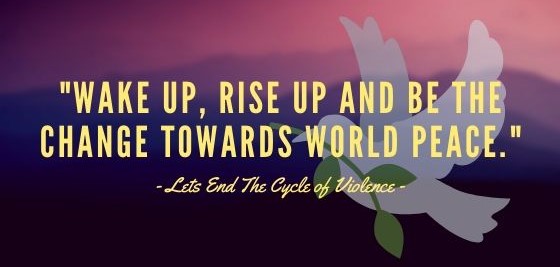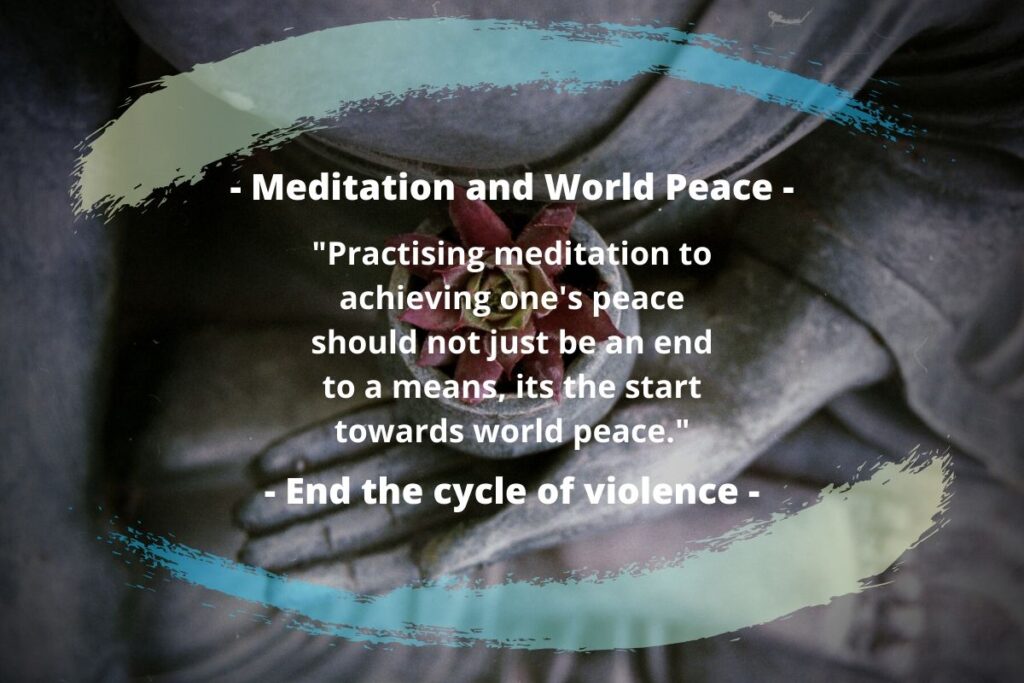While researching online, I came across research articles arguing how meditation can help in ending “the cycle of violence” and help achieve world peace through the cultivation of mindful awareness (Brantmeier, 2007; Tanabe, 2016). Although going through some social media posts on meditation, you might also get the perception of meditation being like “some kind of drug”, one can use to achieve some altered states of consciousness or send us on an emotional high. Used this way, meditation makes us oblivious to our real problems and the problems we are facing right now as a collective.
Meditation is there to produce awareness
Meditation primary purpose is not to achieve some altered states of consciousness or send us on an emotional high, or raise our vibration as this solves nothing. Meditation is there to produce awareness in us and in our society.
Meditation is much more than something you practice for yourself. It is something you do to benefit both ourselves and others through bringing awareness into our actions. Because only through awareness of the consequences of our positive, neutral and negative actions and what gives rise to them can we end the cycle of violence in ourselves each other and the world as a whole.
But you might argue that this might be impossible. As it is more akin to a shift in consciousness and to achieve that there has to be a “collective enlightenment”. Such a mentality just preserves the status quo.
How do we end the cycle of violence?
The starting point is ourselves. We ourselves have to contribute, in small and large ways, toward ending our “own violence” first. By, looking deeply with clarity. By observing without interference or judgment the nature of our minds. Because as we have seen in our previous blog article what we judge, we cannot understand.
When we observe the nature of our mind and the thoughts that arise within, without interference and judgment, we start to bring an all-encompassing objective nonjudgement awareness into our thoughts and the actions resulting from such thoughts, there causes and consequences. By doing so, with time, you will begin to see what is to be done and what is not to be done to bring about a real change in ourselves.
But at the same time, we have to keep in mind that we cannot force change. Why? Because for change to happen first, there must be understanding as change without understanding is doomed to fail. It is only once there is awareness and understanding as Anthony De Mello once said:
Change will happen, you will not have to bring it about. As the life of awareness settles on your darkness, whatever is evil will disappear. Whatever is good will be fostered.
(De Mello, 1992, p. 20)
Being peace
But how might changing oneself affect others and help achieve world peace? As the peace activist A. J. Muste said, “There is no way to peace, peace is the way” (as cited in Hanh, 1992).
Meaning that peace is not something we aspire to achieve in the future, and it is neither something that stems from or is dependent for its realisation on our past. The realisation of peace happens right now in the present with our every look, through our every thought, through a smile, by our words, and every action we take. Each step we take should be peace, should be joy, should be happiness and filled with kindness and compassion towards each other. Practising meditation to achieving one’s peace should not just be an end to a means, its the start towards world peace (Hanh, 1992).
Because in the long run the purpose of meditation is not only to help us achieve an inner sense of tranquillity, but one of the main aims of meditation is to help us become more compassionate towards ourselves and each other. That means that by helping us be more compassionate, we become more adept and sensitive to recognise the suffering within oneself and others, its root causes and consequences, with such understanding that we become deeply committed to trying to prevent and relieve it.
Research also supports this and shows that meditation makes us become more emphatic and able to resonate with other peoples suffering (Condon et al., 2013; Weng et al., 2013). And therein lay the connection between meditation and world peace. In that meditation helps us build the resilience to connect with each other’s sorrows and realise that we all suffer and that acting with compassion towards each other is our shared humanity. Such that the transcendence of suffering through compassion opens our eyes to the interconnection that exists between us. The metaphysical poet John Donne (1572-1631) writes:
No man is an island, entire of itself; every man is a piece of the continent, a part of the main. If a clod be washed away by the sea, Europe is the less, as well as if a promontory were, as well as if a manor of thy friends or of thine own were: Any man’s death diminishes me, because I am involved in mankind, and therefore, never send to know for whom the bell tolls; it tolls for thee.
(Donne, 1624, XVII. Meditation)
What John Donne meant is that no matter how isolated a person is or feels we are all connected and make part of humanity. Part of a community that is greater than ourselves but defined by each and every one of us and that the careless loss of any life is just detrimental to all of us as a whole and only perpetuate humanities suffering.
So by being part of this whole and simultaneously part of a larger whole, we can, in reality, change the world by simply changing ourselves. How might that be? Reflect on the following sentence; “If in this moment I become a centre of compassion love and kindness, then in perhaps a small but not insignificant way, the world now has a nucleus of compassion, love and kindness that it lacked a moment before.”
You are the change
The crux of this all is that we must keep in mind that human society is an extension of the individual, but it also defined and made by the individual. Therefore, if we really want radical change, if we want to end violence and work towards a better world and world peace, we need to change individually. As the poem attributed to Lao-Tzu (6th century BC) points out:
If there is to be peace in the world, There must be peace in the nations. If there is to be peace in the nations, There must be peace in the cities. If there is to be peace in the cities, There must be peace between neighbours. If there is to be peace between neighbours, There must be peace in the home. If there is to be peace in the home, There must be peace in the heart.
– (Attributed to Lao-Tzu, 570-490 BCE, as cited in Jansen, 2018, p. 1)
As such, ask yourself, is there peace in your hearth? And end this article with the following thought for reflection, that if we want to end the cycle of violence to achieve world peace, “let’s stop pointing fingers at others and start by pointing the finger at ourselves.”

References
Brantmeier, E. J. (2007). Connecting inner and outer peace: Buddhist meditation integrated with peace education. Journal of Peace Education and Social Justice, 1(2), 120-157.
Condon, P., Desbordes, G., Miller, W. B., & DeSteno. (2013). Meditation increases compassionate responses to suffering. Psychological Science, 24(10), 2125-2127. doi:10.1177/0956797613485603
De Mello, A. (1992). Awareness: The Perils and Opportunities of Reality. (F. Stroud, Ed.) New York, NY: Doubleday.
Donne, J. (1624). Devotions upon emergent occasions, Meditation XVII.
Hanh, T. N. (1992). Peace is every step: The path of mindfulness in everyday life. New York, NY: Bantam.
Jansen, K. L. (2018). Peace and penance in late mediaeval Italy. New Jersey: Princeton University Press.
Tanabe, J. (2016). Exploring a Buddhist peace theory. Cultural and Religious Studies, 4(10), 633-644. doi:10.17265/2328-2177/2016.10.004
Weng, H. Y., Fox, A., Shackman, A. J., Stodola, D. E., Caldwell, J. Z., Olson, M. C., . . . Davidson, R. J. (2013). Compassion training alters altruism and neural responses to suffering. Psychological Science, 24(7), 1171-1180. doi:10.1177/0956797612469537


I think in the Western world we need it especially more, given the fast-paced lifestyle we live and that we are arguably more selfish than other cultures. Indeed, Western society is described as being individualistic although that is not to say that it is all wrong. But many people turn to the wrong solutions for peace and general relationship problems: drugs and alcohol. And this is turn causes even more problems. I look forward to the day when meditation is taught to children in school here in Malta.
🙂